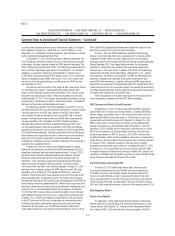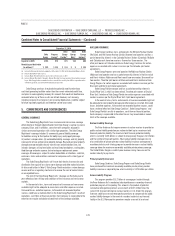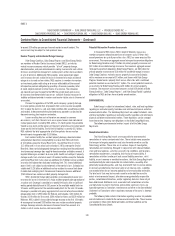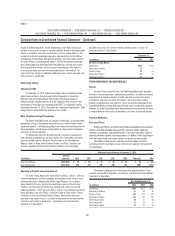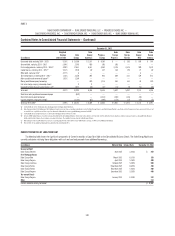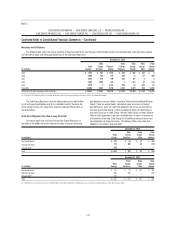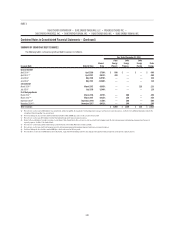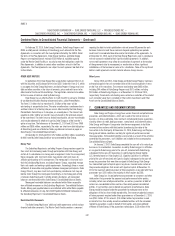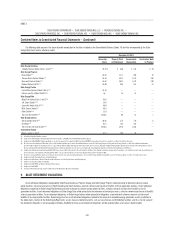Duke Energy 2014 Annual Report Download - page 154
Download and view the complete annual report
Please find page 154 of the 2014 Duke Energy annual report below. You can navigate through the pages in the report by either clicking on the pages listed below, or by using the keyword search tool below to find specific information within the annual report.
134
PART II
DUKE ENERGY CORPORATION • DUKE ENERGY CAROLINAS, LLC • PROGRESS ENERGY, INC. •
DUKE ENERGY PROGRESS, INC. • DUKE ENERGY FLORIDA, INC. • DUKE ENERGY OHIO, INC. • DUKE ENERGY INDIANA, INC.
Combined Notes to Consolidated Financial Statements – (Continued)
North Carolina Ash Basin Grand Jury Investigation
As a result of the Dan River ash basin water release discussed above,
DENR issued a Notice of Violation and Recommendation of Assessment of
Civil Penalties with respect to this matter on February 28, 2014, which the
company responded to on March 13, 2014. Duke Energy and certain Duke Energy
employees received subpoenas issued by the United States Attorney for the
Eastern District of North Carolina in connection with a criminal investigation
related to the release and all 14 of the North Carolina facilities with ash basins
and the nature of Duke Energy’s contacts with DENR with respect to those
facilities. This is a multidistrict investigation that also involves state law
enforcement authorities.
On February 20, 2015, Duke Energy Carolinas, Duke Energy Progress and
Duke Energy Business Services LLC (DEBS), a wholly owned subsidiary of Duke
Energy, each entered into a Memorandum of Plea Agreement (Plea Agreements)
in connection with the investigation initiated by the United States Department
of Justice Environmental Crimes Section and the United States Attorneys for
the Eastern District of North Carolina, the Middle District of North Carolina and
the Western District of North Carolina (collectively, USDOJ). The Plea Agreements are
subject to the approval of the United States District Court for the Eastern District of
North Carolina and, if approved, will end the grand jury investigation related to the
Dan River ash basin release and the management of coal ash basins at 14 plants in
North Carolina with coal ash basins, as discussed above.
Under the Plea Agreements, the USDOJ charged DEBS and Duke Energy
Progress with four misdemeanor CWA violations related to violations at Duke
Energy Progress’ H.F. Lee Steam Electric Plant, Cape Fear Steam Electric Plant
and Asheville Steam Electric Generating Plant. The USDOJ charged Duke Energy
Carolinas and DEBS with fi ve misdemeanor CWA violations related to violations
at Duke Energy Carolinas’ Dan River Steam Station and Riverbend Steam Station.
DEBS, Duke Energy Carolinas and Duke Energy Progress also agreed (i) to a
fi ve-year probation period, (ii) to pay a total of approximately $68 million in
fi nes and restitution and $34 million for community service and mitigation (the
Payments), and (iii) to establish environmental compliance plans subject to the
oversight of a court-appointed monitor paid for by the companies for the duration
of the probation period (iii) for Duke Energy Carolinas and Duke Energy Progress
each to maintain $250 million under their Master Credit Facility as security to
meet their obligations under the Pleas Agreements, in addition to certain other
conditions set out in the Plea Agreements. Payments under the Plea Agreements
will be borne by shareholders and are not tax deductible. Duke Energy
Corporation has agreed to issue a guarantee of all payments and performance
due from the Companies, including but not limited to payments for fi nes,
restitution, community service, mitigation and the funding of, and obligations
under, the environmental compliance plans. As a result of the Plea Agreements,
Duke Energy Carolinas and Duke Energy Progress recognized charges of
$72 million and $30 million, respectively, in the fourth quarter of 2014. The
amounts are recorded in Operation, maintenance and other on the Consolidated
Statements of Operations and Comprehensive Income.
The Plea Agreements do not cover pending civil claims related to the Dan
River coal ash release and operations at other North Carolina coal plants. Duke
Energy Corporation will continue to cooperate with government agencies and
defend against remaining civil litigation associated with these matters.
Duke Energy Carolinas
New Source Review
In 1999-2000, the U.S. Department of Justice on behalf of the EPA fi led a
number of complaints and notices of violation against multiple utilities, including
Duke Energy Carolinas, for alleged violations of the New Source Review (NSR)
provisions of the Clean Air Act (CAA). The government alleges the utilities violated
the CAA when undertaking certain maintenance and repair projects at certain
coal plants without (i) obtaining NSR permits and (ii) installing the best available
emission controls for sulfur dioxide, nitrogen oxide and particulate matter. The
complaints seek the installation of pollution control technology on generating
units that allegedly violated the CAA, and unspecifi ed civil penalties in amounts
of up to $37,500 per day for each violation. Duke Energy Carolinas asserts there
were no CAA violations because the applicable regulations do not require NSR
permitting in cases where the projects undertaken are “routine” or otherwise do
not result in a net increase in emissions.
In 2000, the government sued Duke Energy Carolinas in the U.S. District
Court in Greensboro, North Carolina, claiming NSR violations for 29 projects
performed at 25 of Duke Energy Carolinas’ coal-fi red units. Duke Energy Carolinas
asserts the projects were routine and not projected to increase emissions. The
parties subsequently fi led a stipulation agreeing to dismiss with prejudice all but
13 claims at 13 generating units, 11 of which have since been retired. The parties
fi led opposing motions for summary judgment on the remaining claims. The Court
substantially denied both motions for summary judgment. A Duke Energy request for
leave to fi le another motion for summary judgment on alternative grounds, including
expiration of the applicable statute of limitations, was denied. On October 24, 2014,
Duke Energy Carolinas fi led a motion to certify an appeal of the statute of limitations
issue to the U.S. Court of Appeals for the Fourth Circuit. That motion is pending.
Trial date has been set for October 2015. It is not possible to predict whether Duke
Energy Carolinas will incur any liability or to estimate the damages, if any, it might
incur in connection with this matter. Ultimate resolution of these matters could have
a material effect on the results of operations, cash fl ows or fi nancial position of
Duke Energy Carolinas. However, the appropriate regulatory recovery will be pursued
for costs incurred in connection with such resolution.
Asbestos-related Injuries and Damages Claims
Duke Energy Carolinas has experienced numerous claims for
indemnifi cation and medical cost reimbursement related to asbestos exposure.
These claims relate to damages for bodily injuries alleged to have arisen from
exposure to or use of asbestos in connection with construction and maintenance
activities conducted on its electric generation plants prior to 1985. As of
December 31, 2014, there were 54 asserted claims for non-malignant cases
with the cumulative relief sought of up to $11 million, and 28 asserted claims for
malignant cases with the cumulative relief sought of up to $7 million. Based on
Duke Energy Carolinas’ experience, it is expected that the ultimate resolution of
most of these claims likely will be less than the amount claimed.
Duke Energy Carolinas has recognized asbestos-related reserves of
$575 million at December 31, 2014 and $616 million at December 31, 2013.
These reserves are classifi ed in Other within Deferred Credits and Other
Liabilities and Other within Current Liabilities on the Consolidated Balance
Sheets. These reserves are based upon the minimum amount of the range
of loss for current and future asbestos claims through 2033, are recorded on
an undiscounted basis and incorporate anticipated infl ation. In light of the
uncertainties inherent in a longer-term forecast, management does not believe
they can reasonably estimate the indemnity and medical costs that might be
incurred after 2033 related to such potential claims. It is possible Duke Energy
Carolinas may incur asbestos liabilities in excess of the recorded reserves.
Duke Energy Carolinas has third-party insurance to cover certain losses
related to asbestos-related injuries and damages above an aggregate self-
insured retention of $476 million. Duke Energy Carolinas’ cumulative payments
began to exceed the self-insurance retention in 2008. Future payments up to
the policy limit will be reimbursed by the third-party insurance carrier. The
insurance policy limit for potential future insurance recoveries for indemnifi cation





